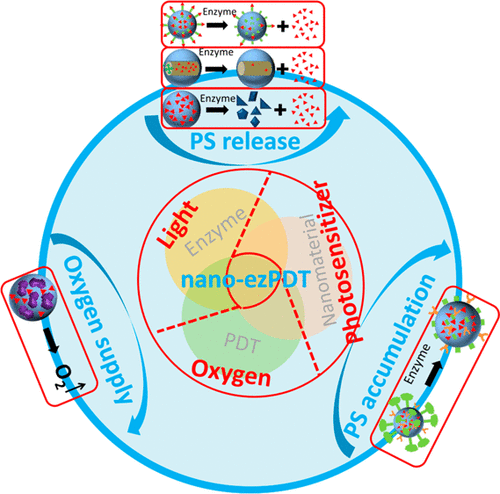当前位置:
X-MOL 学术
›
ACS Biomater. Sci. Eng.
›
论文详情
Our official English website, www.x-mol.net, welcomes your feedback! (Note: you will need to create a separate account there.)
Enzyme-Assisted Photodynamic Therapy Based on Nanomaterials
ACS Biomaterials Science & Engineering ( IF 5.8 ) Pub Date : 2020-01-15 , DOI: 10.1021/acsbiomaterials.9b00968 Baoji Du 1 , Ching-Hsuan Tung 1
ACS Biomaterials Science & Engineering ( IF 5.8 ) Pub Date : 2020-01-15 , DOI: 10.1021/acsbiomaterials.9b00968 Baoji Du 1 , Ching-Hsuan Tung 1
Affiliation

|
Photodynamic therapy (PDT) is a noninvasive cancer treatment that requires the copresence of a photosensitizer (PS), oxygen, and light. The efficacy of conventional PDT is usually limited by two factors: delivery of the PS to the tumor and the hypoxic solid tumor environment. To improve the efficacy of PDT, nanomaterial-based, enzyme-assisted PDT (nano-ezPDT), which integrates enzyme-responsive components into nanomedicines, was developed for enhanced PS delivery and oxygen generation. Nano-ezPDT is designed to take full advantage of the catalytic function of locally activated tumor-associated enzymes or smuggled exogeneous enzymes. The enhancement of PS release and accumulation is often controlled by endogenous enzymes upregulated at the tumor sites. Oxygen generation, however, relies mostly on catalase-loaded nanomedicines. In this review, we discuss the associated enzymes, constructs, and types of nanocarriers and highlight the principle and utility of nano-ezPDT for cancer therapy.
中文翻译:

基于纳米材料的酶辅助光动力疗法
光动力疗法(PDT)是一种非侵入性癌症疗法,需要光敏剂(PS),氧气和光共同存在。常规PDT的功效通常受两个因素限制:将PS递送至肿瘤和低氧实体瘤环境。为了提高PDT的功效,开发了基于纳米材料的酶辅助PDT(nano-ezPDT),该酶将酶反应成分整合到了纳米药物中,以增强PS的递送和氧气的产生。Nano-ezPDT被设计为充分利用局部激活的肿瘤相关酶或走私的外源酶的催化功能。PS释放和积累的增强通常由肿瘤部位上调的内源酶控制。然而,氧气的产生主要依赖于负载过氧化氢酶的纳米药物。在这篇评论中
更新日期:2020-01-15
中文翻译:

基于纳米材料的酶辅助光动力疗法
光动力疗法(PDT)是一种非侵入性癌症疗法,需要光敏剂(PS),氧气和光共同存在。常规PDT的功效通常受两个因素限制:将PS递送至肿瘤和低氧实体瘤环境。为了提高PDT的功效,开发了基于纳米材料的酶辅助PDT(nano-ezPDT),该酶将酶反应成分整合到了纳米药物中,以增强PS的递送和氧气的产生。Nano-ezPDT被设计为充分利用局部激活的肿瘤相关酶或走私的外源酶的催化功能。PS释放和积累的增强通常由肿瘤部位上调的内源酶控制。然而,氧气的产生主要依赖于负载过氧化氢酶的纳米药物。在这篇评论中



























 京公网安备 11010802027423号
京公网安备 11010802027423号